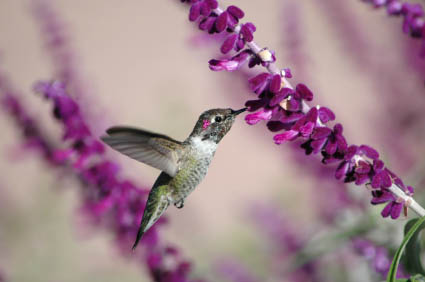
For those who enjoy bird-watching or gardening, there is a plentitude of herbs and plants that attract hummingbirds. While red flowers are notorious for attracting hummingbirds, you are not limited to just this color. White, purple, pink, orange and blue flowers that are rich in nectar can be incorporated into a hummingbird garden. When selecting herbs and plants for your yard or garden, it’s important to consider some criteria. Diversify your choices and increase your landscape with a wide range of sizes, forms and colors. Consider the ease of planting and maintenance, early or long blooming periods and attractiveness of foliage. With careful planning of your garden for hummingbirds, you will be rewarded later with happy hummers throughout your garden.
A Brief History of the Hummingbird
Hummingbirds were thought to be a mix between a bird and an insect by the first European settlers. Euro-Americans were also fascinated by the extravagantly colored creatures. It wasn’t until 1758 that hummingbirds were described and published by biologist Linnaeus. During the eighteenth century, French naturalist, Buffon, also attempted to catalog the world’s hummingbirds, calling them “fly-birds.” By the middle of the nineteenth century, a large market for hummingbirds was present in Europe. Their skins were sold to markets all over London and surrounding cities. By this time, hummingbirds were also used in art. Between 1849 and 1861, John Gould of England had published a five-volume monograph that consisted of 360 hand-colored lithographs of hummingbirds.
Location and Environment
Hummingbirds reside in the America’s, ranging from southern Alaska to Chile. A large majority are found in tropical and subtropical South and Central America. Most hummingbirds of Canada and the United States migrate south during the winter months to northern Mexico or Central America. Few species are round-the-year residents of interior desert regions and warmer coastal areas. Hummingbirds tend to inhabit parks, thickets, gardens and forest edges. They will typically live anywhere with small bugs and where nectar producing flowers thrive.
What Do Hummingbirds Eat?
Hummingbirds drink nectar, a sweet fluid found inside certain nectar-producing flowers. They are able to assess the amount of sugar taken from the nectar and reject flowers that contain less than 10 percent sugar. Hummingbirds feed in many smaller meals and consume up to 12 times their own body weight in nectar each day. They also consume small invertebrates. Hummingbirds spend an average of 15 percent of their day feeding and up to 80 percent sitting and digesting.
Attracting Hummingbirds – Herbs
Hummingbirds will sip nectar from various herbs that produce tubular flowers. This includes most members of the sage and mint families, as well as mallows and lavender. Four great herbs that will help attract hummingbirds to your garden include pineapple sage (Salvia elegans), red bee balm (Monarda didyma), anise hyssop (Agastache foeniculum) and hummingbird sage (Salvia guaranitica). Each of these herbs for hummingbirds are relatively easy to grow and produce nectar-rich blooms.
Attracting Hummingbirds – Houseplants
The key to attracting hummingbirds is to plant a wide variety of flowers that will provide shelter, security, shade and food. Flowering shrubs, herbs, vines and dwarf trees can be used to create an ideal habitat that begins at ground level and grows 10 feet or more. Planting brightly colored flowers that hold large amounts of nectar will attract hummingbirds. These include perennials such as columbines and daylilies; biennials such as hollyhocks and foxgloves; and annuals such as impatiens, cleomes and petunias.
Hummingbird Resources
